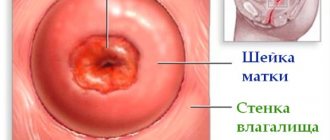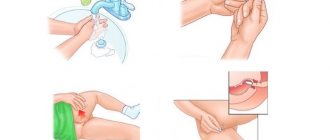Modern methods of treating the disease
If erosion is not treated in a timely manner, a woman may experience negative complications. The cauterization procedure is painless. It is performed on an outpatient basis. At the same time, eroded tissue is eliminated and the woman’s reproductive ability is preserved.
The most common methods for removing erosion are:
- Freezing with liquid nitrogen.
- Cauterization with electric current.
- Cauterization with laser.
- Cauterization by radio waves.
- Chemical exposure.
Methods of diagnosis and treatment
To avoid complications that may accompany erosion treatment, it is necessary to perform some types of research. Diagnosis for cervical erosion includes:
- gynecological examination with a vaginal speculum;
- smears for flora, cytological examination;
- bacteriological culture;
- colposcopy of simple and extended varieties;
- biopsy if cancer is suspected;
- blood tests for HIV, syphilis, hepatitis.
An examination is necessary to prescribe treatment, which can be either medicinal or surgical. Since complications after congenital erosion of the cervix are usually not observed, doctors in this case use observational tactics. After normalization of hormonal levels, such a formation can regress on its own.
Conservative treatment is recommended for nulliparous women, as well as before and after the cauterization procedure. Conservative therapy includes:
- antibacterial drugs;
- drugs with antiviral, regenerative and antifungal effects;
- antiseptics;
- complex of vitamins;
- physiotherapy.
Conservative therapy is the main treatment method for nulliparous women, as it does not cause complications. However, drug treatment is not always effective and has a high relapse rate.
In most cases, to eliminate cervical erosion, cauterization is necessary. In modern gynecology, several cauterization tactics are used in women.
- Diathermocoagulation. A method called diathermocoagulation involves cauterization with an electric current. Diathermocoagulation is carried out at the end of the menstrual cycle. After cauterization by diathermocoagulation, a burn occurs that heals within two months. Diathermocoagulation is considered an effective, but quite traumatic method of treatment. After diathermocoagulation, the development of complications in the form of scar formation is possible. Gynecologists note that after cauterization with electric current, there is a risk of infection.
- Cryodestruction. The method is not essentially cauterization, as it involves exposure to ultra-low temperatures of dry ice or liquid nitrogen. But the term “cauterization” has taken root in everyday life for this method. The procedure is carried out with liquid nitrogen, which freezes the area of erosion. This cauterization is used for small defect sizes, since the method is characterized by insufficient efficiency. Due to its gentle effects and the absence of complications, cauterization with liquid nitrogen can be recommended for nulliparous women.
- Chemical coagulation. Cauterization involves repeated treatment of the pathological area of the cervix with a chemical solution. This technique has a high risk of relapse as a complication.
- Laser vaporization. This is a non-contact cauterization method that involves removing erosion with a laser. Among the main advantages of this gentle intervention, gynecologists highlight the high efficiency, painlessness of the procedure and the absence of complications.
- Radio wave surgery. Cauterization is carried out using the Surgitron apparatus, which simultaneously disinfects pathological areas. This is a gentle modern method that is successfully used in nulliparous women.
The choice of cauterization method is determined by the doctor. Important criteria are the woman’s age, medical history and type of erosion.
Diathermocoagulation is considered one of the oldest and most traumatic methods. However, due to the availability and effectiveness of diathermocoagulation, such cauterization is performed quite often.
Consequences of cauterization with liquid nitrogen
The essence of the nitrogen cauterization method is the direct effect of sub-zero temperature on the affected area. As a result, dead and rejected cells are replaced by healthy tissues. Liquid nitrogen is used for the procedure.
Advantages of the method
Among the advantages of cauterization with liquid nitrogen, the following should be noted:
- quick procedure;
- no bleeding;
- low risk of complications;
- affordable price.
Freezing with nitrogen is considered a gentle procedure that does not leave scars. After cryodestruction, the woman can immediately go home.
Disadvantages of the method
Despite all the advantages, nitrogen cauterization has the following disadvantages:
- Long recovery period.
- Pain may occur.
- Additional procedures may be necessary because the doctor is unable to control the depth of treatment.
- Damage to healthy tissue and scarring may occur.
- Colorless exudative discharge for a month.
If the exudative discharge has an odor, you should inform your doctor.
Doctors recommend not using vaginal tampons until the wound has healed completely, as well as sexual abstinence for a month.
Cauterization with nitrogen is considered effective, but not an ideal method of curing pathology. When freezing with nitrogen, tissue elasticity is preserved, so it is prescribed for the treatment of nulliparous women.
Pain after cervical biopsy
A clarifying gynecological examination if dysplasia or cancer is suspected is called a cervical biopsy. Only the results of a test for the benignity of the cells allow the gynecologist to draw up a treatment plan. The procedure is very painful and is performed under the influence of an anesthetic injection or general anesthesia.
If, after a cervical biopsy, the lower abdomen hurts and is accompanied by spotting for up to 7 days, as well as pain in the depths of the vagina and the body temperature rises to 37.5°C, these are symptoms that the biopsy was performed correctly.
Attention! In rare cases, a complication may occur, including heavy bleeding, smearing for 7 days, discharge with an unpleasant odor, fever over 37.5 ° C, you need to call a doctor.
Consequences of laser cauterization
The purpose of laser cauterization is to destroy the erosive area using a high-precision laser. In this case, healthy tissues are not affected. This technique allows you to maintain the normal functioning of the reproductive system.
Advantages of the method
Compared to other methods, laser cauterization has the following advantages:
- minimal damage to healthy tissue;
- using a video colcoscope you can observe the process;
- minimal risk of scars and narrowing;
- short rehabilitation period;
- there is practically no pain.
The female body recovers quickly after the procedure. The method is used to treat nulliparous women.
Disadvantages of the method
In some situations, after cauterization with a laser, the following consequences may appear:
- As a result of a large area of exposure or insufficient qualifications of the doctor, a scar may form.
- There is a risk of infection of the wound surface and the development of inflammatory processes.
Consequences may arise if the patient does not adhere to the rules of personal hygiene and the doctor’s recommendations.
During the recovery period, it is recommended to avoid sexual contact, heavy physical activity, heavy lifting, and visiting swimming pools and saunas. You should also avoid drinking alcohol and using vaginal tampons for a month.
How does erosion heal after cauterization?
I often go to the site, read your diaries, comments, I decided to write for the first time, there will be a lot of text.
.. I have been planning a pregnancy for 5 years (I got married in May 2014, before that we dated for 5 years, took contraception, immediately after the wedding we began to actively plan, everything was on the doctor’s recommendation (STIs, hormones, ultrasound, etc.) , in the end it turned out that progesterone was low, they prescribed duphaston, took 3 cycles and on the 3rd cycle two lines on the test, but it all ended in tears, spontaneous miscarriage at 19 weeks (((divorced from my former husband. After that, problems with the cycle began, for a long time I didn’t have my period, the doctor prescribed Duphaston, there was bleeding in one cycle, I stopped it. Again, tests for hormones, progesterone was low, everything else was normal, so a year passed. On the recommendation, I went to see an expensive doctor, again hormones, infections... During this period, I married another person, again planning. The doctor begins my treatment with cauterization of the erosion (I had it a long time ago, but the doctor said that according to the tests it was bad HPV), they did cauterization, everything took a long time to heal, sometimes sometimes twice a week I went to her for treatment, it took a lot of money ( according to my calculations, it would be enough for IVF):(((plus the hormones also reveal an increased level of prolactin, I take Dostinex... As a result, I come for treatment for the last time in May, the doctor says to try to plan a pregnancy (before that there was a ban on pa, until cauterization will not heal)... We try... As a result, an ectopic pregnancy in July, surgery, removal of the left tube, depression, long rehabilitation until November, the legs do not go to their doctor... Again, consultation with a new doctor (already in the medical department). the center where the rehabilitation took place): hormones, STIs... After rehabilitation, it is advised to actively plan, because rehabilitation procedures give the best effect in the first 6 months (again, a lot of money). The doctor again prescribes Dostinex (after the operation everything was canceled, i.e., from July to December she did not take anything). Prolactin decreases to normal, but progesterone is practically zero, periods come as they want... She advised the endocrine specialist to replace Dostinex with bromocriptine, and said that in general Dostinex is not needed, because increased inactive prolactin, active in perfect order... The gynecologist prescribed stimulation of ovulation with clostilbegit under ultrasound control. P.S. Girls, sorry for the long text, I wrote more for myself, so as not to forget the whole sequence of events, there’s already a mountain of papers and extracts, but there’s no point, and I’m waiting for your support and advice, it’s scary to start stimulation….
Consequences of cauterization by radio waves
The peculiarity of cauterization with radio waves is the absence of human exposure to the erosive area. Using special equipment, the affected cells are crushed. The electrodes create high-frequency waves that partially melt the tissue. Subsequently, they evaporate and not a trace remains of erosion.
Advantages of the method
Cauterization of erosion with radio waves has recently become increasingly popular due to the following advantages:
- Absolute safety.
- Do not harm healthy tissues, since the effect occurs only on affected tissues.
- Minimum recovery period.
- Allows you to cure erosion in 1 procedure.
- After cauterization with radio waves, no traces of erosion remain.
- Does not cause burns.
This method is suitable for treating women of any age and even nulliparous women.
Disadvantages of the method
Despite the advantages of the method, some women may experience negative consequences:
- Discharge for 10 days. They may be white, and in some cases with blood in them.
- Pain in the lower abdomen for 3 days.
Diagnosis of pain in the lower abdomen
A routine examination by a gynecologist is carried out at least once every six months. When interviewing a doctor, it is necessary to clearly give answers and describe the existing symptoms. If, for example, the uterus and cervix hurt during pregnancy, this may be a sign of cervical dilatation. Having found out why the cervix hurts, the specialist provides approximate diagnoses:
- Erythroplakia – thinning of the mucous membrane;
- Ectropion – cervical canal with signs of everted mucosa;
- Leukoplakia is a modification of epithelial skin areas that develops after operations and injuries;
- Cervical erosion;
- Pseudo-erosion, or ectopia;
- It is necessary to take a smear for flora and carry out a cytological examination;
The specialist’s diagnosis is confirmed by performing a gynecological examination of the vagina, cervix and vulva using speculum and a colposcope. Many women believe that after a colposcopy the lower abdomen hurts and are worried about having it done, but when they begin to experience pain in the cervix when walking, they change their minds. Even dilation of the vagina with speculums causes painful sensations for sensitive women; it is recommended to immediately tell the doctor to use a smaller size of instruments. Colposcopy is painless; the patient only experiences a feeling of anxiety, a feeling of pressure, and a slight spasm.
Attention! If a woman begins to experience sharp, causeless cramping pain, with a burning sensation when urinating, sometimes nausea and even vomiting is possible, with loss of consciousness, most likely an ovarian rupture has occurred, and an emergency call to the ambulance is required.
Reviews from patients from various sources
Women leave the most positive reviews after cauterizing erosion with radio waves and lasers. These procedures do not require pain relief.
Sveta, 30 years old
I was diagnosed with the disease when I was pregnant. The gynecologist recommended cauterization of the erosion with nitrogen after childbirth. The doctor told me everything about treatment and rehabilitation. The doctor warned me that I would have to abstain from sexual activity for a month. The procedure was painless, but afterwards there was aching pain in the lower abdomen. For several days I was bothered by discharge. I spent 3 months on rehabilitation, and I no longer remember the erosion.
Katerina, 22 years old
Cauterization of erosion was carried out twice. At first they cauterized with radio waves in a private clinic. A very expensive procedure. After 2 months, I underwent a preventive examination and, as it turned out, the erosion remained. The second time they cauterized it with a laser at the antenatal clinic. And this method helped me.
When choosing a method to cure erosion, the doctor evaluates the form of erosion and the severity of the disease in order to avoid the development of negative consequences. Adhering to the doctor’s recommendations will allow you to quickly recover after the cauterization procedure and avoid the formation of consequences.
Video: Cauterization of cervical erosion using cryodestruction
Cervical erosion cryodestruction
Consequences after cauterization
The main method of treating erosion for more than a decade has been cauterization of the altered epithelium to form a superficial wound on the cervix. Thanks to this, the ulcers are gradually covered with a layer of healthy cells or connective tissue, forming a small scar that does not cause harm to health.
Unfortunately, in some cases, unpleasant consequences are observed after the procedure, including pain and bleeding. Discharge is also possible - mucous discharge from the wound. If after the procedure you bleed and the blood flows profusely, a large vessel may have been damaged. In this case, you should immediately consult a doctor, he will help stop the bleeding.
Weak nagging pain in the lower abdomen is relieved with antispasmodics, for example, No-shpa and spasmalgon. But before taking them, it is also advisable to consult a doctor.
What medications to take after cauterization of cervical erosion
Every second woman, according to statistics, is faced with a benign pathology of the cervix, which is called erosion. This pathological condition often occurs in the form of ectopia, which requires surgical treatment.
Ectopia can be eliminated by cauterization. There are various cauterization tactics, which are selected individually taking into account the characteristics of the anamnesis. In gynecological practice, a fairly effective cauterization method called diathermocoagulation has been used for many years. This method involves cauterization with electric current.
In some cases, after diathermocoagulation there is a need for drug treatment. The use of medications in the recovery period after electric cauterization shortens the rehabilitation period and activates regeneration processes.
Many women who have been diagnosed are interested in what erosion is. In fact, this definition is not entirely correct, since it does not reflect all the processes that occur with a given condition of the cervix. In the medical literature, it is common to use the term “ectopia”.
If a spot or epithelial defect appears on the vaginal part of the cervix, they speak of the development of erosion. This is a benign background process that must be treated in order to prevent more serious diseases.
It is possible to conclude how serious the erosion is only by determining its type. Gynecologists classify erosion as:
The cervix is a kind of muscular tube that connects the organ cavity and the vagina through the cervical canal. Erosion occurs in the visible area of the cervix, which is called vaginal due to its location.
The vaginal part of the cervix is examined by a gynecologist during an examination. Normally, the epithelium of this area has a pale pink tint and is lined with flat cells. In addition, the epithelium of the vaginal part of the cervix is multilayered.
The cervical canal differs in the structure of its epithelium, as it consists of cylindrical cells. Such epithelial tissue is single-layered and its appearance is always hyperemic. The texture of the epithelium of the cervical canal is velvety. It is noteworthy that the cervical canal also contains mucus-producing glands, which prevent infection from spreading into the uterus from the vagina.
It has been established that during intrauterine development, the vaginal area of the cervix can be covered with cylindrical cells, which, as the reproductive system develops, move towards the cervical canal. This congenital ectopia is considered a normal variant and regresses until the age of 23-25 years.
However, congenital ectopia does not always disappear. Sometimes a reddish spot of an even shape does not regress, but is complicated by infection. In this case, drug treatment is necessary.
If the epithelial tissue of the cervix is damaged, a wound is formed, called true erosion. Traumatic, burn, and infectious factors lead to the appearance of such an ulcer. The wound is usually accompanied by an inflammatory process.
True erosion heals on its own within two weeks, which is why the ulcer is rarely detected. If a wound is identified during a gynecological examination, drug treatment is prescribed.
Often there is healing of epithelial tissue that does not occur correctly. As a result, erosion becomes covered with cells that are unusual for the vaginal area of the cervix. The wound heals with the help of cylindrical cells, forming acquired ectopia or pseudo-erosion.
Gynecologists recommend treating ectopia, as there is a danger of its degeneration. In addition, pseudo-erosion is usually accompanied by inflammatory processes.
Erosion refers to pathologies that can arise due to many reasons, both external and internal. Among the reasons for the appearance of erosion, experts note:
- intrauterine features of the development of the genital organs;
- hormonal fluctuations that lead to changes in epithelial tissue;
- infectious pathogens, such as chlamydia and HPV;
- onset of sexual activity at a young age;
- irregular sexual contacts;
- presence of several partners;
- cervical injuries, in particular during childbirth and abortion.
Some patients believe that cervical erosion can cause various symptoms. In fact, if a defect causes pathological discharge, cycle disturbances or pain, then it is necessary to conduct an examination and identify concomitant diseases.
Erosion can only be accompanied by contact discharge that occurs during intimacy or examination of the cervix, as well as mucous discharge. It is known that the glands of cylindrical cells produce mucus, including on the surface of pseudo-erosion.
However, signs of erosion are determined visually during a gynecological examination of the cervix. The specialist identifies a spot that has characteristic symptoms that attribute it to a specific variety.
True erosion is similar to a wound, often with signs of an inflammatory process. Congenital ectopia is an evenly shaped spot that rarely becomes infected. Pseudo-erosion looks like a defect of uncertain shape and volume. As a rule, with such a pathology, pathogenic microflora is diagnosed.
The defect is detected during a gynecological examination. But more research is needed to differentiate the spot from other diseases. First of all, it is necessary to exclude dysplasia and oncology, as well as identify concomitant diseases that need to be treated before cauterization.
Diagnosis for erosion includes:









